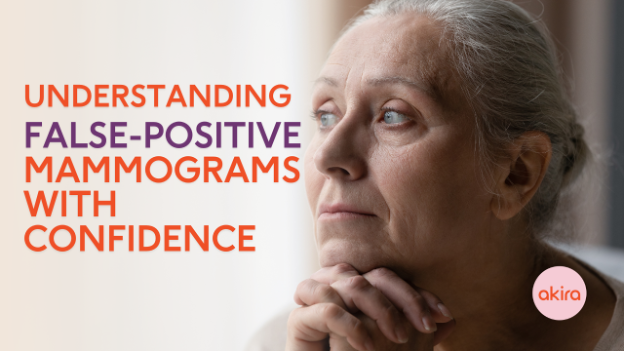
If your phone rings after a routine mammogram and you hear that you need more tests, it’s natural for your heart to skip a beat. That wave of worry—even panic—has a name: “Scanxiety.” You might remember we explored this in our previous post, where we shared ways to ease those anxious moments. It’s completely normal to feel anxious or unsettled when faced with unclear results, but please know—so many women walk this same path, and you’re not alone.
Let’s dive in together: we’ll clarify what a false-positive mammogram means, why it happens, and how you can feel empowered through the entire process.
What Is a False-Positive Mammogram?
A false-positive mammogram occurs when your screening flags an abnormality, but follow-up tests—like additional imaging or a biopsy—show there’s no cancer. False positives are more common than many realize, here’s some helpful context:
- About 10% of screening mammograms lead to callbacks [National Cancer Institute].
- Over 90% of callbacks are non-cancerous [American Cancer Society].
- Across 10 years of annual screenings, 50–60% of women experience at least one false positive [UC Davis Health].
These statistics highlight that false positives are part of a careful, proactive system that puts your health first.
Why Do False Positives Happen?
Several common factors can increase the odds of a false-positive mammogram:
Dense Breast Tissue: If you have dense breasts, it’s harder for mammograms to distinguish between normal and abnormal tissue, so callbacks are a bit more likely.
Your First Mammogram: Without a prior image for comparison, radiologists may recommend follow-up for anything unusual.
Age: Younger women are more likely to have dense breast tissue, increasing their chances of false positives.
Benign Findings: Non-cancerous conditions like cysts or calcifications can resemble suspicious changes on a mammogram but can be harmless.
Why a False Positive Shows the System Is Working
A false-positive result is not a failure—it’s evidence of a sensitive and cautious process. Today’s mammograms are designed to find changes early, often before symptoms appear. Just like a smoke detector, it’s better for the system to be overly cautious than miss something important. This vigilance increases your chance of catching breast cancer at its most treatable stage.
The Importance of Continuing Regular Mammograms
Don’t let the experience of a false-positive deter you from future screenings. Annual mammograms remain the most effective tool for early breast cancer detection, and survival rates are highest when the disease is found early. According to the American Cancer Society, the five-year relative survival rate for localized breast cancer (cancer that has not spread outside the breast) is over 99%.
Tips to Stay Proactive
Book Your Next Mammogram
Keeping up with your annual screening is one of the best things you can do for your health. Request that appointment today. Let’s get it on the calendar!
Know Your Breast Density
Dense breast tissue is common—and knowing your density can help determine if you might benefit from additional imaging like a breast ultrasound.
Gather Your Records
Having your past screening results in one place makes it easier for your care team to spot any changes and support your next steps. At Akira, we work to gather your previous images if you’ve had a mammogram at another facility.
Learn What to Expect
Understanding the screening process can help you feel more prepared and confident before your appointment.
Talk to Your Care Team
You know your body best. Share your questions, speak up about changes, and ask about what’s right for you.
Take Charge of Your Health with Akira
At Akira, we know that false-positive mammogram results can be unsettling, but they’re a normal part of a careful screening system. Staying informed, communicating with your providers, and keeping up with annual exams can give you confidence and peace of mind.
Ready to prioritize your breast health? Request your mammogram with Akira today. If you want to stay updated on the latest breast health news, sign up for our newsletter. We’re honored to support you—let’s work together toward a healthier tomorrow!